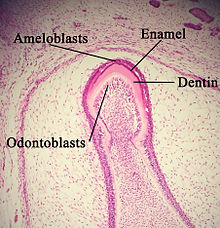Adamantoblast
Adamantoblasts (from ancient Greek άδάμας (adamas) "indomitable", "diamond" and βλἀστη (blastä) "germ"), ameloblasts ( old Greek amel "enamel") or enameloblasts are specialized cells that form tooth enamel . They are of surface ectodermal origin and differentiate from the epithelium enameleum (inner enamel epithelium) in the course of tooth development . They are also known as ganoblasts .
After the dentin begins to form through the odontoblasts, they form the tooth enamel, which consists predominantly of hydroxyapatite . The exocytosis of the secretory vesicles, in which the substances for the organic framework of the enamel are located, occurs at the cell apex, where there is also a clumsy process, the Tomes process. After enamel formation is complete, the ameloblasts transform into squamous cells of the border epithelium. In doing so, they lose the ability to divide. When the teeth erupt, these cells eventually migrate towards the gingival sulcus (furrow between tooth and gum) and are rejected. Therefore, tooth enamel cannot regenerate .
literature
- Hubert Ernst Schroeder: Orale structural biology , 5th edition, Thieme Verlag, Stuttgart 2000, ISBN 3-13-540905-8 .
See also
Individual evidence
- ^ Walter Hoffmann-Axthelm : Lexicon of Dentistry , Quintessenz-Verlag, Berlin
- ↑ Welsch: Textbook Histology , 2nd edition, Elsevier, Munich 2006
